Introduction
At the 26th Conference of the Parties (COP26) to the United Nations Framework Convention on Climate Change (UNFCCC) in Glasgow, the United Kingdom, on the morning of 10 November 2021, Cambodia stated in its statement “Reduce deforestation by half–maintain 50% of Forest Cover by 2030 and no carbon footprint–Zero carbon emission by 2040”. Cambodia has set a goal of reducing emissions by 42% by 2030, thereby developing a long-term Zero Carbon Emissions Strategy (Carbon-neutral strategic plan) to promote CarbonTech, climate-resilient and inclusive development.
The Forestry Administration has identified indicators and input data to contribute to achieving a long-term Zero Carbon Emissions Strategy (Carbon-neutral strategic plan) through key measures, inclusive of: (1) establishing community forests; (2) strengthening sustainable forest management; (3) promoting the distribution of seedlings and planting trees in all forms on degraded forest lands and private lands to reduce pressures on natural forests; and (4) developing and promoting agroforestry practices in both community forests and private lands.

To contribute to climate change adaptation, community livelihood improvement for both short and long-term, and reforestation are determined in the expected impacts of the project “The registration of small-scale private forest plantation in Cambodia” funded by the Government of the Republic of Korea through the Asian Forest Cooperation Organization (AFoCO). In these respects, the customized forestation models of tree plantations and agroforestry practices have been promoted through the free-of-charge distribution of seedlings to local communities, the monitoring the survival rate of seedlings, as well as the promotion of private forest registration to ensure the legal source of timber production originating from tree plantations.
From late 2019 to mid-2021, the project team has collaborated with officials of the Department of Forest Plantation and Private Forest Development, Kampong Cham Forestry Administration Cantonment, Western Kampong Cham Forestry Administration Division, and Chamkar Leu Forestry Administration Triage to distribute more than 102,500 seedlings to local communities residing in Kampong Cham province. Those local communities include about 2,340 families from 64 villages, monks at 7 pagodas, and local authorities of 16 communes in Kampong Siem, Chamkar Leu and Stung Trang districts. The distributed seedlings consist of 16 species of local indigenous tree species that include mostly the luxury grade and high-commercial timber species (Dalbergia cochichinensis; Pterocarpus pedatus, Pierre; Afzelia xylocarpa, (Kurz) Craib.; Sindora cochinchinensis, Baill.; Xylia dolabriformis, Benth.; Dalbergia barriensis, Pierre; Dipterocarpus alatus, Roxb; Hopea odorata, Roxb.; Albizia lebbeck, (L) Benth.; Lagerstroemia loudonii; Anishoptera costata, Korth; Diospyros cruenata, Thwaites.; Shorea siamensis;); and fast-growing tree species (Tectona grandis, L.f.; Swietenia macrophylla; Azadirachta indica); and 4 species of fruit trees such as mango; jackfruit; Java plum; soursop. These seedlings are to be grown on the compound of pagodas, yards of schools, commune centers and local public institutions, as well as public squares such as along the streets and public parks, planting as tree plantations and agroforestry forms, such as intercrops mixed with fruit trees or vegetables, or living fence.
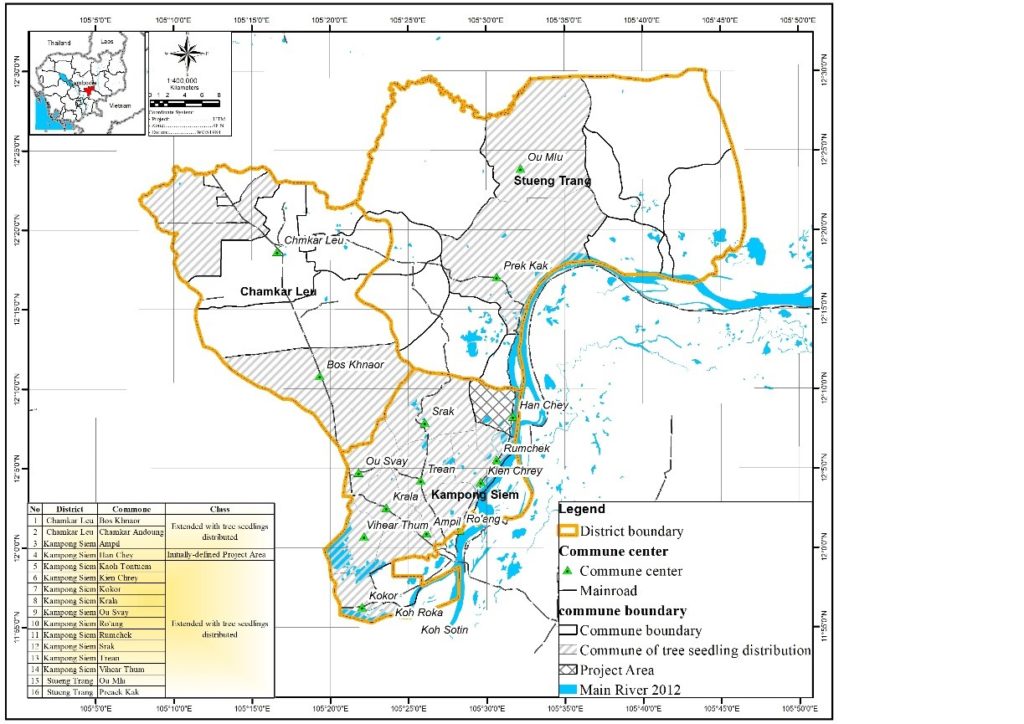
Initially, the project identified only Han Chey commune as the project’s target commune, but the land available for tree planting was limited, so the project sites for distributing tree seedlings were expanded to 16 communes in three districts in Kampong Cham province.
These three districts used to be rich natural forests, especially before the 1960s. Later, due to population growth and the rapidly increasing need for land for agricultural development, the forestland has been converted into agricultural land, especially rubber plantations, cassava and fruit trees.
(Map) The project sites were expanded to 16 target communes for the distribution of seedlings to the local communities including people, monks, and public institutions in 3 districts of Kampong Cham province
The project distributed more than 102,000 saplings to local communities, including farmers and the private sector (private plantation owners), more than 2,340 families, as well as monks at pagodas. The following three-plantation owner, farmer, and monks were selected for interviews in order to present their personal perspectives on tree planting efforts under various models that are customized contributing to reforestation in project areas. These will play an important role in changing the mindset of others in their community.
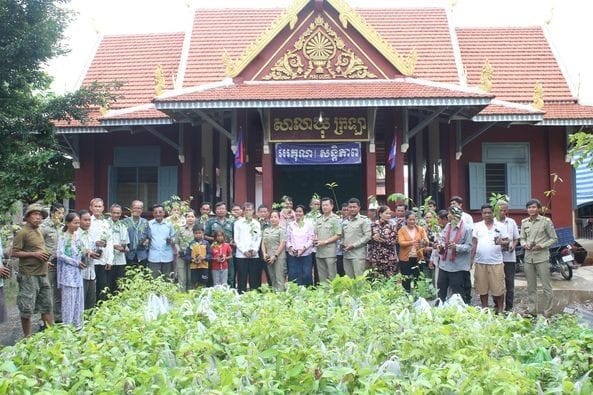

Why does Mr. Keo Kosal continue to expand his private tree plantations?
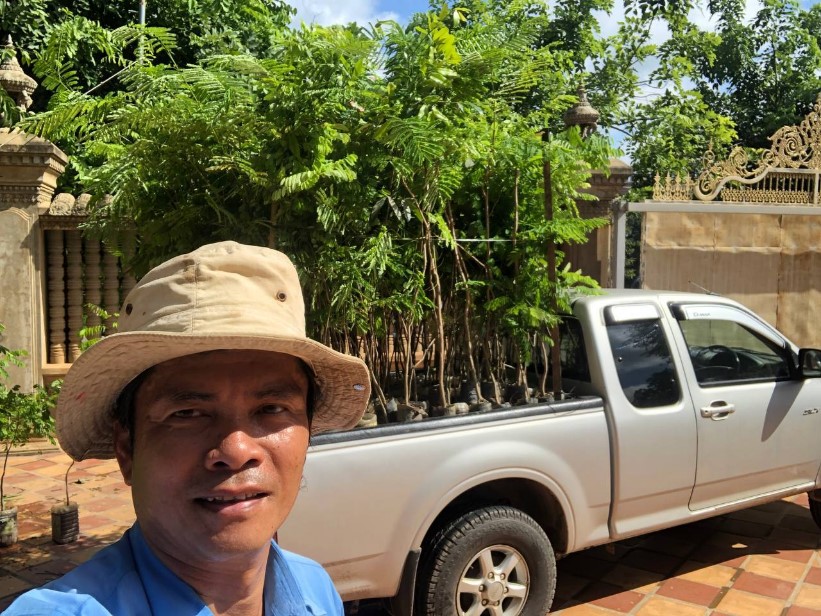
“Tree planting is a reflection of our active efforts to restore graded forest and make green forest cover grow bigger, adapting to climate change which is a major global concern”,
Mr. Keo Kosal
Mr. Keo Kosal is the owner of a medium-sized tree plantation of 90 hectares in Han Chey Commune, Kampong Siem district, Kampong Cham province. About 85 hectares are grown with indigenous and fast-growing trees, while the other 5 hectares are invested with agricultural crops and partly planted with trees. The teak plantations are dominant, making up 82% or 70 hectares of the total tree plantations he has been investing since 2012.
(Photo) Mr. Keo Kosal, an owner of private tree plantations, who received seedlings from the project and planted as tree plantations in Han Chey commune, Kampong Siem district, Kampong Cham
Initially, he planted only teak trees on about 30 hectares and, in recognition of the importance of forest resources due to the declining natural forestland and increasing wood demand and market prices, he has expanded his tree plantations and set up his own nurseries to produce teak seedlings and other luxury high-valuable tree species. This contributes to reduction of serious pressure on natural forest resources. The expansion of tree plantation is intended every year with the cultivation of more than 20 species of indigenous and fast-growing trees planted in mono-species blocks and some blocks mixed with a few tree species. The main purpose is to sell to infrastructure development projects, Real Estates, construction projects, and plant nurseries and stalls in Phnom Penh and other provinces. That is, not until has the wood been harvested, many seedlings that have been grown 3-4 years may be dug around their stumps and packed as small trees for selling out. This, in combination with income sourced from agricultural crops that provide short-term profit (Cash crops), allows him to raise capital in the short term to continue the plantation business and plant nursery sustainably. Although such a quick-return business does not yield in wood harvest, it is a customized forestation model where seedlings are planted in urban and suburban areas, residential areas, public places, private lands, or amusement parks, restaurants and environmental improvements in natural resorts to be more stunningly attractive. These are all parts of urban forest modernization in a novel context of socio-economic development where forest resources contribute to the sustainable development of society, environment, economy and human welfare, which is also part of sustainable forest management and conservation of forest genetic resources.
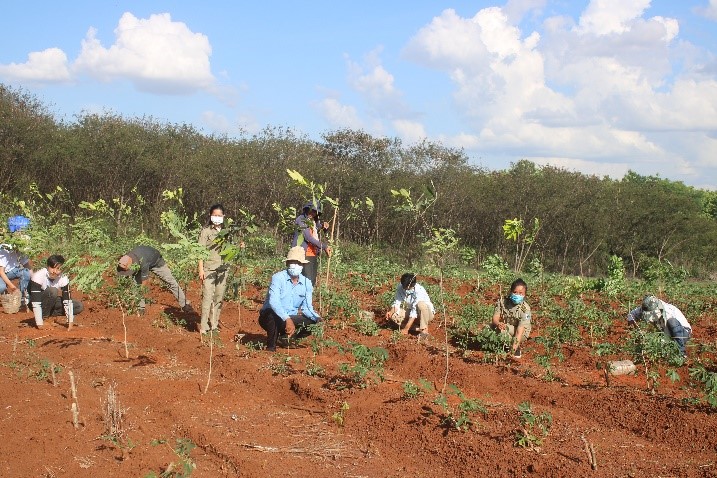
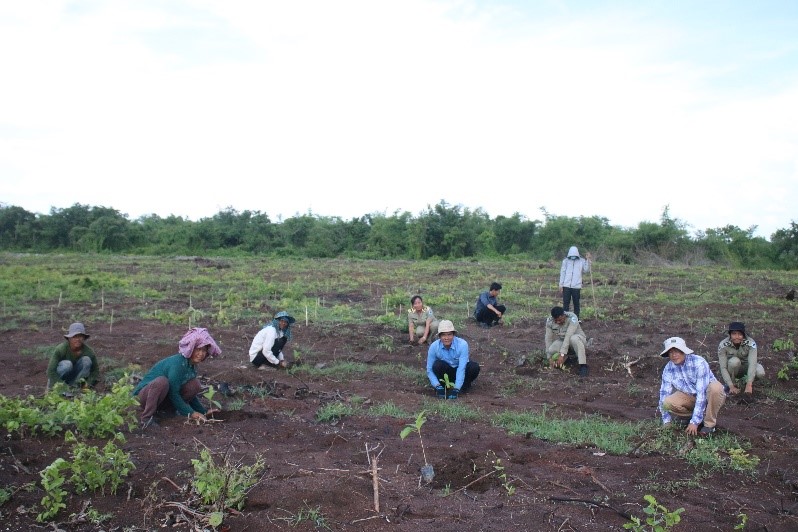
“Forests not only help people, animals and the environment, but the forest as a barrier to prevent erosion, landslides, natural disasters, storms, droughts and so on; forest landscape provides stunning views to attract more and more national and international tourists, which is an important source of income for the community and the nation as a whole.”
Mr. Keo Kosal
Apart from doing business, Mr. Keo Kosal is also a farmer who loves natural ecosystem; he spends almost 60% of his monthly time visiting his tree plantations, which he sees a beautiful natural environment and fresh cool air. At the end of 2019, since the project began to distribute seedlings to local communities, small-scale farmers, pagodas and public institutions in Han Chey commune, Mr. Keo Kosal requested the project for seedlings to be further planted on his remaining land. He received more than 20,000 seedlings with about 10 species of trees (Dalbergia cochichinensis; Dalbergia barriensis, Pierre; Diospyros cruenata, Thwaites.; Pterocarpus pedatus, Anishoptera costata, Korth; Pierre; Dipterocarpus alatus, Roxb; Afzelia xylocarpa, (Kurz) Craib.; Xylia dolabriformis, Benth.; Sindora cochinchinensis, Tectona grandis, L.f.).
There are not many farmers/owners who occupy plantations ranging from 10-100 hectares in the project area due to the high demand of resources needed for development on such as large-scale monoculture plantation, which requires a lot of start-up capital and long-term investment time. However, the lessons learned here are a good practice for reforestation in the project area.
Pagodas Play Crucial Roles in Contributing to Reforestation
The project “The Registration of Small-scale Private Forest Plantation in Cambodia” funded by the Government of the Republic of Korea through the Asian Forest Cooperation Organization (AFOCO) has provided more than 30,000 seedlings to monks at seven pagodas in the three districts of Kampong Cham province. These pagodas include O’da, Koh Prak, Krala, Andong Svay, Vihear Thom, and Kdei Boeung pagoda. Koh Prak pagoda is located in Koh Prak commune, Stung Trang district, Kampong Cham province, which has received more than 3,000 seedlings to be planted on more than 2 hectares of pagoda land and in the pagoda compound. The 2-hectare-land was previously flooded bush during rainy season and produced no any production. Once the project distributed seedlings to the pagoda, Venerable Vanny Ratana ordered to refill the land to be higher and planted trees on the land.
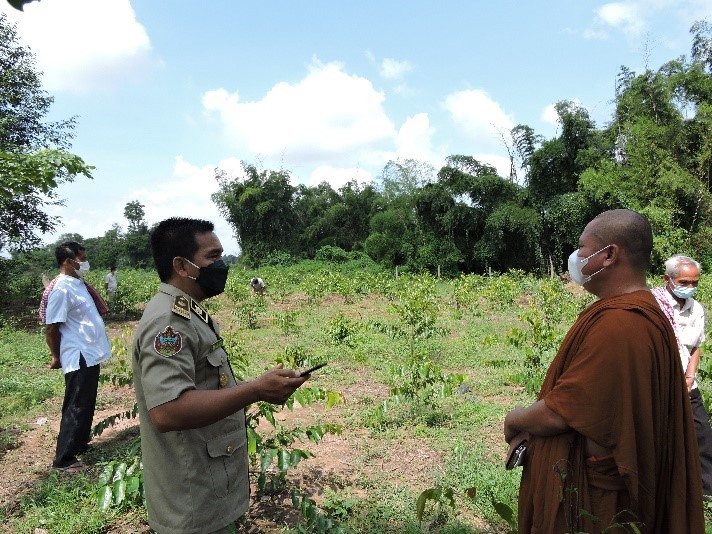

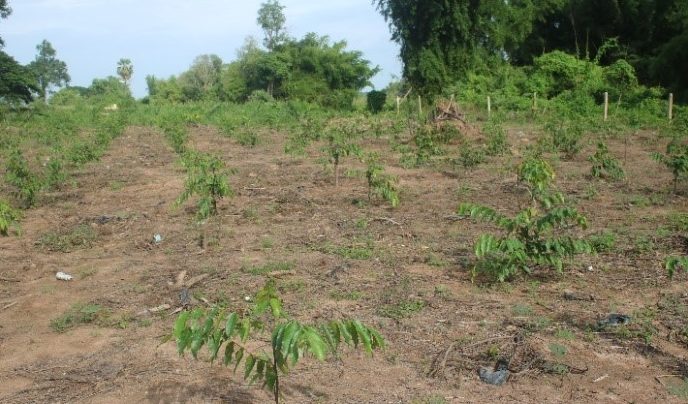
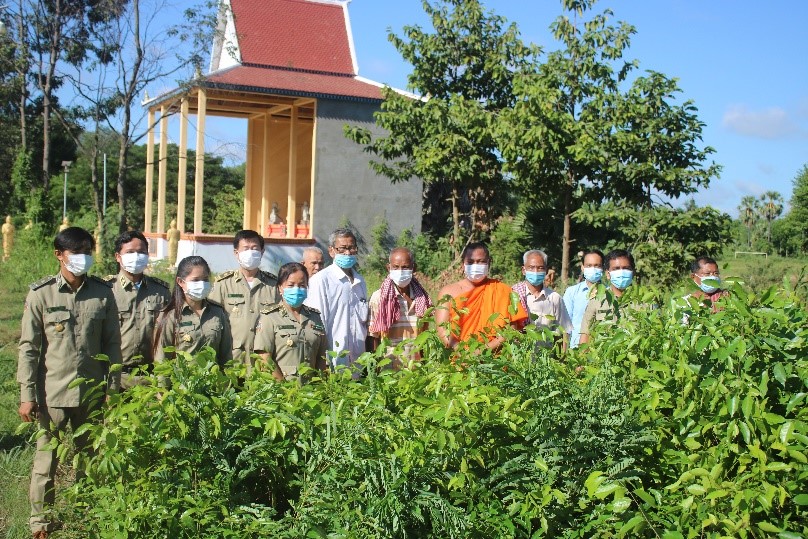
“Planting trees has a straight meaning for the movement to get people to love the forest, participate in planting and protecting the forest, and it, consequently, helps to support people with their subsidiary needs, improving agricultural productivity, increasing family well-being, as well as improving the social environment”,
Venerable Vanny Ratana
For general observation, the land of pagodas in the rural areas, especially in the project area, are generally spacious where trees can be planted to the shade and change the mindset of local communities. This can be primarily initiated by the monks, then spread to buddhists and public institutions about their participations in reforestation in their community, as well as environmental protection and natural resource conservation. The current trend, pagodas play a significant role in educating and promoting the reforestation in addition to religious, spiritual, cultural, traditional and literary education. This education is related to the activities and environment existing in the pagoda, such as meditation that is a practical example that are closely conjunction to nature surrounded. Therefore, planting trees creates an environment with fresh peasant air, which facilitates in meditation and other educational processes.
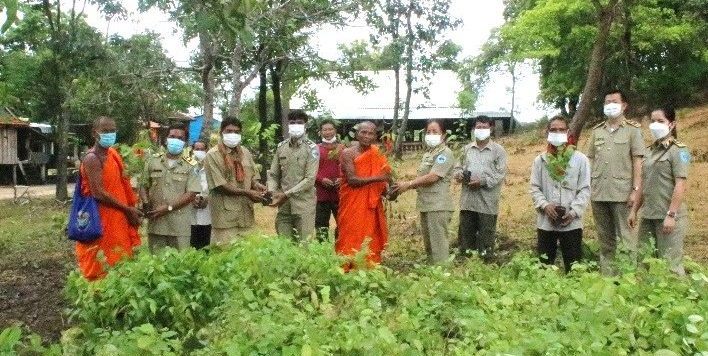

“Please contribute to the protection of forests and the natural environment, and wildlife of all kinds, as well as biodiversity, in order to sustain for the benefit of our own lives, communities, especially to mitigate and prevent natural disasters such as storms, floods, droughts, etc … I would like to request the AFoCO project and the Forestry Administration to continue to provide more seedlings, especially rosewood, for not just pagodas but also buddhists to cultivate for the prospective generations, as well as future needs.”
Venerable Vanny Ratana
Perspectives on planting trees on his private land, Mr. Sean Sun
Mr. Sean Sun, O’Svay village chief, received more than 1,250 seedlings from the project to plant on a 4 ha plot and mixed with agricultural crops. His main goals are, for the short-term, to be harvested or resold small trees, and for the long-term, to remain known by his descendants, to use or yield in economic return in addition to the importance of balancing the environment.
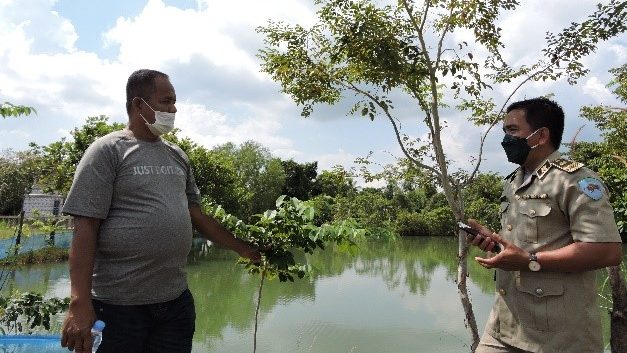
“My goal is for the next generation to see these luxurious and high-valuable tree species, especially the benefits of the forest that comes from the heritage that we are all striving to cultivate”, and continued, “Forests can provide benefits such as the shade, habitat for animals, shelters for humans, fertilizer for paddy rice field, and prevention of storms.”,
Mr. Sean Sun
(Photo) Project team met with Mr. Sean Sun, O’Svay village chief, who received seedlings from the project to plant as intercrop tree plantation and living fence on his land in Han Chey commune, Kampong Siem district, Kampong Cham province.
Mr. Sean Sun recalled that he used to seek for buying these luxury tree seedlings at the market, which were usually sold at US$1/seedling (0.4 m tall) for almost all kinds of high-commercial tree species. Fortunately, he received the seedlings from the project free, delivered to them at a house with regular follow-up. He advised the villagers to bring those seedlings provided by the project to plant along the fence or grow mixed with agricultural crops (agroforestry) for the current and future benefits.
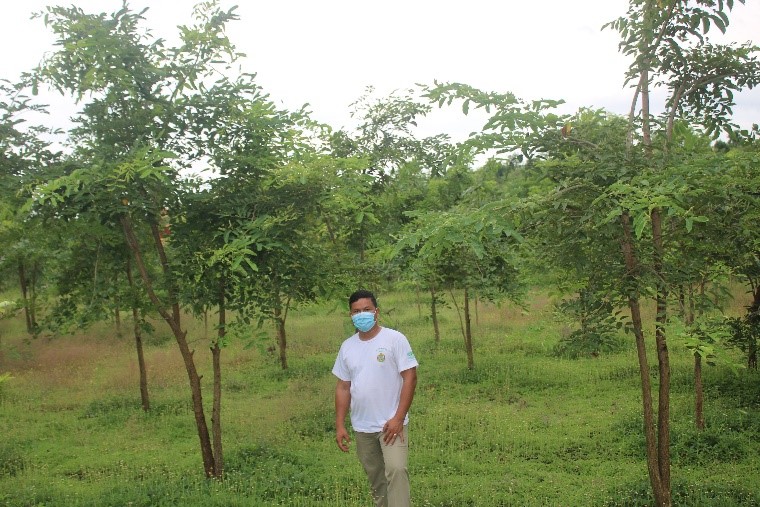
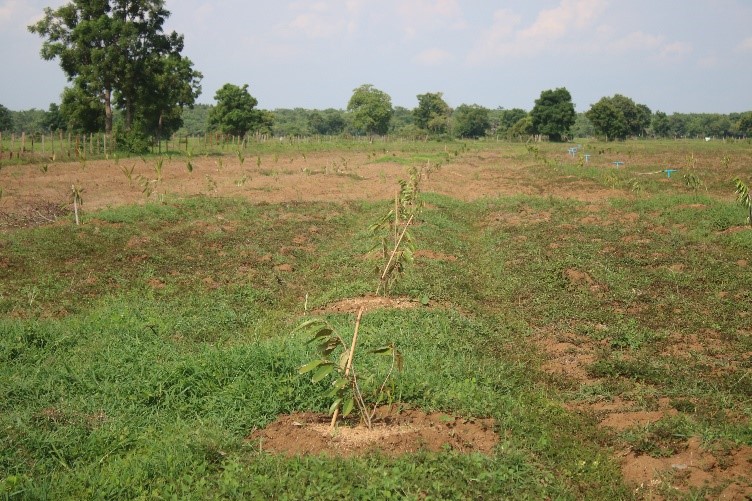
“When it grows, it can provide the shade and be manufactured as furniture and housing due to its high-valuable wood.I feel profoundly happy to get these trees.”
Mr. Sean Sun
Reforestation in Cambodia and the way forward
Maintaining a balanced natural forest ecosystem is fundamental to supporting Cambodia’s sustainable economic development. Forests contribute significantly to all 17 goals of the UN Sustainable Development Goals, ensure food security and safety nets, improve livelihoods, provide employment and reduce poverty, promote nutrition and health, sustain production, economic growth, water resources, and energy. Forests protect fisheries resources, equality of the environment, build partnership policies and education, preserve biodiversity and terrestrial ecosystems, promote gender equality, support urban sustainability, and develop infrastructure to adapt to climate change.
For the way forward, the project to register private forest plantations in Cambodia plans to cooperate with the Department of Development of plantations and private forests to continue to distribute more saplings, as well as to promote the process of registration and development of private forests in Cambodia, especially to expand interest and promote Involve the private sector in investing in a wide range of plantations across Cambodia.
Contributed by Sinly Say, Project Staff for AFoCO/012/2019

